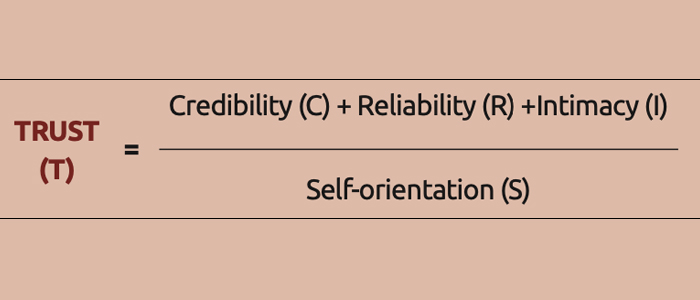Trust works bilaterally. One trusts and the other is trusted. While the two are related, they are not the same. For the one who would be trusted, it’s all about how worthy they are of our trust – how trustworthy they are.
We use the word ‘trust’ to describe what we think of what people say, and also how they behave. We use it to describe whether or not we are comfortable sharing information about ourselves or others with them. And we use it to indicate whether or not we feel other people have our interests at heart, or just their own.
With this in mind, we can represent trust as a simple equation consisting of four variables: credibility, reliability, intimacy and self-orientation.

Let’s look at each in turn...
Credibility comes with what we say, but also reflects our competence. Are we credible on the subjects we talk about? Can customers, patients and other health professionals trust that what we say is correct?
Reliability, by contrast, has to do with our actions, with what we do. It is about keeping promises and delivering on commitments. Someone might say: ‘If they say they will do it, I know they will.’
Intimacy is the sense of safety or security we feel when entrusting someone with something confidential, and the level of confidence we have that they will not share it with anyone else (and so violate our trust).
Self-orientation refers to the focus of the person in question. Is a person’s focus primarily on themselves or on others? We don’t trust people who seem more concerned with how they appear to others than with what they need to do. People with a strong, open character are more likely to be trusted than those who behave in a way that could be perceived as manipulative or duplicitous.
Increasing the value of the factors in the numerator (C+R+I) increases the value of trust. Increasing the value of the denominator (self-orientation) decreases the value of trust. And since there is one variable in the denominator and three in the numerator, self-orientation is the most important factor.
This is intentional. A health professional with low self-orientation is free to focus on the needs of patients and users of their services. This provides a base on which to build credibility, reliability and relationships. Looking at trust this way allows you to build trustworthiness by building credibility and reliability. Working on the four trust values is the best way to increase your trustworthiness.
